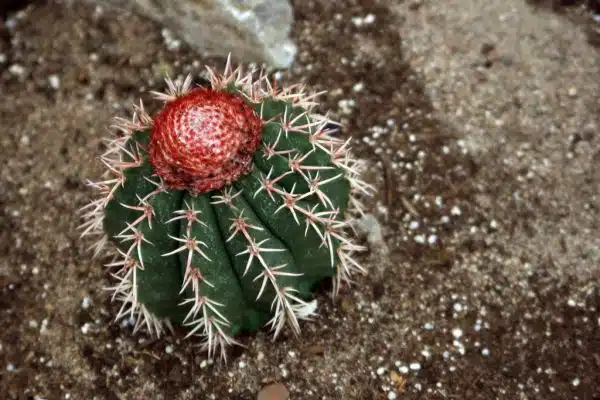Melon cactus, also known as Melocactus, is a unique and fascinating plant species that belongs to the Cactaceae family. These plants are native to tropical and subtropical regions of Central and South America, Mexico, and the Caribbean islands. Melon cacti are characterized by their globular shape, ribbed texture, and distinctive cephalium or woolly top. While they may seem intimidating to grow at first glance, with proper care and attention, they can thrive in a variety of indoor and outdoor settings.
In this article, we will discuss how to grow and care for melon cacti. We will cover everything from selecting the right potting mix to providing adequate lighting conditions for optimal growth. Additionally, we will explore common pests and diseases that affect these plants and offer practical solutions for preventing or treating them. Whether you are an experienced gardener looking to add some diversity to your collection or a beginner seeking a rewarding new hobby, this guide has something to offer anyone interested in cultivating these unique cacti.
Understanding The Melon Cactus
What is a melon cactus? This unique cactus, also known as Melocactus, belongs to the Cactaceae family and is native to South America and the Caribbean. The plant can grow up to 12 inches tall with a diameter of around 8 inches. Melon cacti are characterized by their spherical shape, which looks like a watermelon or a small pumpkin, and their vibrant pink flowers that bloom during summer.
Cultivating melon cacti requires knowledge of their growing habits. Melon cacti prefer warm climates and full sunlight exposure. They thrive in well-draining soil that is slightly acidic with pH levels ranging from 6 to 7.5. It’s important to avoid overwatering the plant since it can cause root rot; instead, water them sparingly every two weeks during the growing season.
Melon cacti are fascinating plants that make great additions to any garden or indoor space. With proper care and attention, you can enjoy these beautiful plants for years to come. Let’s take a closer look at how to choose the right potting mix for your melon cactus.
Choosing The Right Potting Mix
Understanding the Melon Cactus is crucial for its growth and care. To ensure that your cactus grows well, you need to understand its requirements. The Melon Cactus requires bright light, well-draining soil, and moderate watering. Bright light helps the cactus grow healthy while well-draining soil enables water to move through it easily. Overwatering can cause root rot that can be detrimental to your cactus.
Choosing the right potting mix is essential when growing Melon Cacti. Organic potting mixes are ideal as they allow for excellent drainage and aeration of your plant’s roots. You can make your organic potting mix by using a combination of composted organic matter such as peat moss or coconut coir and perlite or pumice. Benefits of composting include reduced waste in landfills, improved soil structure, and increased nutrient availability for plants.
When selecting fertilizers for your Melon Cactus, consider using organic fertilizers over synthetic ones. Organic fertilizers contain natural ingredients that provide essential nutrients for proper plant growth without harming the environment or risking toxicity in the plant’s system. Synthetic fertilizers are often cheaper but have drawbacks such as leaching into groundwater or causing harm to beneficial organisms in the soil. To maintain optimal growth, you should feed your Melon Cactus with fertilizer at least once a month during the growing season.
Selecting the ideal container is an important step when it comes to growing healthy Melon Cacti. A container should have good drainage holes to prevent waterlogging and have enough space to accommodate your plant’s root system comfortably. A container made from porous material such as terra cotta will help wick away excess moisture from the soil while providing ample air circulation around the roots. Ensure that you select a container that is suitable for both indoor and outdoor use based on where you intend to keep your plant.
Selecting The Ideal Container
The proper container size is crucial for the growth and health of melon cactus. It is important to select a container that is deep and wide enough to accommodate the plant’s root system, while also providing ample space for growth. The ideal container should have a diameter of at least 12 inches and a depth of at least 8 inches.
When selecting a container, it is essential to consider drainage. Melon cactus roots are susceptible to rot if they sit in standing water, so it is important to choose a pot with adequate drainage holes. If the selected container does not have drainage holes, it can be fixed by drilling them into the bottom of the pot or adding a layer of rocks or gravel before adding soil.
Choosing the right container for your melon cactus will provide an excellent foundation for its growth and survival. Ensure that you select a pot with appropriate dimensions and sufficient drainage to meet your plant’s needs. Once you have chosen your container, you can move on to providing adequate lighting for your melon cactus.
Providing Adequate Lighting
Melon cactus is a tropical plant that requires adequate lighting to thrive. When growing melon cactus indoors, it is essential to place them in areas that receive bright, indirect sunlight. However, if you do not have access to adequate natural light, you can supplement with artificial lighting.
Indoor placement: Melon cactus needs bright, indirect sunlight to grow healthy and produce fruits. Therefore, when placing your melon cactus indoors, ensure it receives enough light from a north-facing window or any other spot that gets enough sunlight. It is also important to avoid placing the plants in areas where they receive direct sunlight as this can cause sunburns on the leaves.
Artificial lighting: If your indoor space does not have enough natural light for your melon cactus, consider using artificial lighting. You can use fluorescent bulbs or LED grow lights to provide the required spectrum of light for your plants. Ensure that the lights are placed at least six inches above the plants and run 12-16 hours per day.
Here are five important tips on providing adequate lighting for your melon cactus:
- Place your melon cactus in an area that receives bright, indirect sunlight.
- Avoid exposing your plants to direct sunlight as it can cause sunburns.
- Use fluorescent bulbs or LED grow lights if your indoor space has inadequate natural light.
- Place the artificial lights at least six inches above the plants and run them for 12-16 hours per day.
- Monitor how well the plants respond to artificial lighting and adjust accordingly.
Moving forward into watering and fertilizing section…
Watering And Fertilizing
- The watering frequency of a melon cactus should be tailored to the specific conditions of the environment, such as the temperature and humidity, in order to maintain optimal growth.
- It is best to use a balanced fertilizer, such as one with an N-P-K ratio of 10-10-10, to ensure that the melon cactus receives the proper nutrients for its growth.
- The amount of fertilizer used should be carefully monitored, as excessive amounts will result in an unhealthy build-up of nutrients in the soil that can be detrimental to the melon cactus.
- It is also important to ensure that the fertilizer is applied according to the instructions on the packaging, as too much or too little could have a negative impact on the melon cactus.
- It is best to fertilize the melon cactus every two months in order to ensure that it is receiving the essential nutrients it needs.
- The amount of fertilizer used should be based on the size of the melon cactus, with larger plants requiring more fertilizer than smaller plants.
Watering Frequency
One of the most important factors in growing and caring for melon cactus is proper watering. As a horticulturalist, I recommend establishing a watering schedule based on the needs of your specific plant. Melon cactus, like many other cacti, are adapted to survive in arid environments and require less water than other houseplants.
Overwatering can quickly lead to root rot and ultimately kill your melon cactus. Signs of overwatering include mushy or discolored stems, wilting leaves, and a strong unpleasant odor emanating from the soil. To avoid overwatering, it’s best to wait until the top inch or two of soil has completely dried out before watering again.
It’s also essential to use well-draining soil when planting your melon cactus. This allows excess water to drain away from the roots and prevents moisture buildup that can lead to root rot. By following these guidelines for watering frequency, you can ensure that your melon cactus stays healthy and vibrant for years to come.
Fertilizer Types
When it comes to growing and caring for melon cactus, proper watering is just one piece of the puzzle. Fertilization is equally important, as it provides essential nutrients that allow the plant to thrive. There are two main types of fertilizers: organic and synthetic. Organic fertilizers contain natural ingredients such as compost or manure, while synthetic fertilizers are made from chemical compounds.
Organic fertilizers offer several benefits over their synthetic counterparts. They release nutrients slowly over time, providing a steady supply of nourishment for your melon cactus. They also improve soil quality by adding organic matter and beneficial microorganisms. However, organic fertilizers tend to be more expensive and may not provide as many nutrients as synthetic fertilizers.
The frequency of fertilization depends on several factors, including the type of fertilizer used and the age of your melon cactus. In general, it’s best to apply fertilizer during the plant’s active growth period (usually spring and summer) and reduce or eliminate fertilization during the dormant period (fall and winter). Be sure to follow the instructions on your fertilizer package regarding application rates and frequency. Over-fertilization can harm your melon cactus just as much as under-fertilization, so take care not to go overboard with feeding. By choosing the right type of fertilizer and applying it at appropriate intervals, you can help your melon cactus grow strong and healthy for years to come.
Fertilizer Amounts
Proper fertilization is crucial to the growth and health of melon cactus. Organic options are recommended over synthetic fertilizers due to their slow-release of nutrients, which provides a steady supply of nourishment for the plant. They also improve soil quality by adding organic matter and beneficial microorganisms.
The amount of fertilizer applied depends on the type used and the age of your melon cactus. It’s important to follow a timing schedule as well, applying fertilizer during the active growth period in spring and summer and reducing or eliminating it during the dormant period in fall and winter. Over-fertilization can be just as harmful as under-fertilization, so it’s important not to go overboard with feeding.
When using organic options, apply fertilizer at appropriate intervals following instructions on the package regarding application rates. Although they may be more expensive than synthetic fertilizers, organic options provide long-term benefits for both your melon cactus and soil quality. Following proper fertilization practices will help your melon cactus grow strong and healthy for years to come.
Temperature And Humidity Requirements
After properly watering and fertilizing your melon cactus, it’s important to focus on the temperature and humidity requirements. These factors play a critical role in the overall health and growth of your plant. Did you know that the ideal temperature range for a melon cactus is between 65-80°F? This statistic highlights the importance of maintaining an appropriate temperature for your plant to thrive.
Humidity control is another key factor in growing healthy melon cacti. These plants prefer higher levels of humidity than other cacti species, with an optimal range of 50-70%. To achieve this, consider using a humidifier or placing a tray of water near your plant. Additionally, misting the leaves with water can also help increase humidity levels.
Temperature management and humidity control go hand-in-hand when caring for melon cacti. It’s important to maintain consistent conditions as much as possible to prevent stress on the plant. Avoid exposing your cactus to extreme temperatures or sudden changes in humidity levels. By properly managing these environmental factors, you’ll be able to encourage healthy growth and prevent issues such as yellowing or wilting. In the next section, we’ll discuss pruning and propagation techniques to further enhance the beauty of your melon cactus.
Pruning And Propagation Techniques
Pruning is an essential aspect of melon cactus care as it helps to maintain the plant’s shape and health. The frequency of pruning depends on various factors such as the age and size of the cactus, its growth rate, and environmental conditions. It is advisable to prune the melon cactus during its active growing season, which typically occurs in spring and summer. Gardeners can use a clean, sharp pair of pruning shears or scissors to remove any dead or diseased stems, leaves or flowers.
Propagation refers to the process of creating new melon cacti from existing ones. Melon cactus propagation can be achieved through two primary methods: stem cutting and seeds. Stem cutting involves taking a healthy stem from an established plant and planting it in well-draining soil until it develops roots. Seeds are another popular method for propagating melon cacti, although it requires patience as they take longer to germinate than other types of plants. Gardeners should ensure that they use fresh seeds for propagation success rate.
Proper pruning and propagation techniques not only benefit the melon cactus but also enhance its aesthetic value. However, gardeners must pay close attention when pruning or propagating their melon cactus to avoid damaging the plant inadvertently. In addition to these techniques, gardeners should also be aware of common pests and diseases that could affect their plants’ health, such as mealybugs or root rot. Understanding how to identify these issues will help gardeners take appropriate steps to treat them promptly before they cause severe damage to their melon cacti.
As important as pruning and propagation are for maintaining healthy growth in your melon cactus, there are still common pests and diseases you need to watch out for that can harm your plants if left untreated.
Common Pests And Diseases
When growing melon cactus, it is essential to be aware of the common pests and diseases that may affect your plant. As the old saying goes, “prevention is better than cure.” By identifying and addressing these issues early on, you can protect your plant and ensure a healthy harvest.
Common pests that may infest melon cactus are mealybugs, spider mites, and scale insects. Mealybugs are tiny white insects that suck sap from the plant’s tissues, causing stunted growth and yellowing leaves. Spider mites are another pest that feeds on the plant’s sap and causes discoloration of leaves. Scale insects produce a sticky substance called honeydew, which attracts ants and encourages fungal growth.
To control pests in melon cactus, you can use insecticidal soap or neem oil sprays. For mealybugs, rubbing alcohol applied with a cotton swab can be an effective natural remedy. Ladybugs and lacewings are also natural predators of these pests. To prevent further infestation, it is important to maintain proper hygiene by regularly cleaning your plant’s surroundings.
Melon cactus may also fall victim to diseases such as root rot or bacterial soft rot. These diseases can cause wilting of leaves or blackening of stems. To combat them naturally, you can use cinnamon powder or hydrogen peroxide solutions as disinfectants for infected areas. Proper drainage and adequate airflow can prevent root rot from occurring in the first place.
By being proactive in identifying potential issues with melon cactus, you can take steps to prevent and treat any problems before they become severe. Whether through chemical or natural means, controlling pests and diseases will help ensure a healthy harvest for your plants.
Preventing And Treating Issues
Now that you are aware of the common pests and diseases that can affect your melon cactus, it is essential to prevent and treat issues as soon as possible. One of the most effective ways to keep your melon cactus healthy is by providing proper care, which includes regular watering, fertilization, and sunlight. However, despite your best efforts, problems may still arise.
Some common problems that you may encounter while growing melon cactus include root rot, sunburn, and mealybugs. Root rot is caused by overwatering or poor drainage, leading to the decay of roots. Sunburn occurs when the cactus is exposed to direct sunlight for extended periods without acclimating first. Mealybugs are tiny insects that suck sap from the plant’s tissues and leave behind a white powdery substance.
Fortunately, there are many effective remedies available for treating these issues. For root rot, remove any affected parts of the plant and repot in fresh soil with improved drainage. To prevent sunburn, gradually introduce your cactus to more sunlight over time or provide shade during peak hours. Mealybugs can be removed manually with a damp cloth or controlled with insecticidal soap or neem oil spray.
By being proactive in preventing and treating problems with your melon cactus promptly, you can help ensure its long-term health and success. With proper care and attention, you can enjoy watching your thriving melon cactus grow and thrive in your home or garden space.
Enjoying Your Thriving Melon Cactus
Like any other plant, the key to enjoying a thriving melon cactus is proper care and maintenance. With proper watering, fertilization, and sunlight exposure, your melon cactus can grow into a stunning centerpiece for your garden or indoor display. As it matures, you will notice that its unique shape and texture add an interesting twist to any creative display ideas you may have in mind.
Harvesting and using melon cactus fruit is a simple yet rewarding activity. Once the fruit has ripened, which usually takes around 80-100 days after planting, carefully cut it off with a sharp knife. The fruit can be eaten fresh or used as an ingredient in various recipes such as jams, jellies, and even cocktails. Its juicy flesh and sweet flavor make it a popular choice among food enthusiasts.
As you continue to care for your melon cactus plant, don’t forget to take time to appreciate its beauty and versatility. Whether you decide to display it indoors or outdoors, this unique plant is sure to be a conversation starter among your guests. By following these tips on how to grow and care for melon cactus plants, you can enjoy their aesthetic appeal along with the wonderful flavors of their fruit for years to come.
Conclusion
The Melon Cactus is a unique addition to any indoor or outdoor garden. With the right care and attention, this cactus can flourish into a beautiful and healthy plant. It is important to select the right potting mix and container, provide adequate lighting, and properly water and fertilize the plant. Regular pruning and propagation can also help maintain its shape and health.
However, like any plant, the Melon Cactus may fall victim to pests and diseases. Preventative measures such as proper watering techniques and regular monitoring can help avoid these issues. If problems do arise, prompt action is necessary to prevent further damage.
Overall, with patience and dedication, growing and caring for a Melon Cactus can be a rewarding experience for any gardening enthusiast. As horticulturalists, we must remember that every plant has its own unique beauty that deserves to be nurtured and appreciated. So let us all continue to cultivate our green thumbs and enjoy the wonders of nature in our own homes.
Image Credits
- “Melon cactus” by quinn.anya (featured)





























